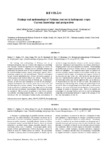Please use this identifier to cite or link to this item:
http://www.alice.cnptia.embrapa.br/alice/handle/doc/576855| Title: | Etiology and epidemiology of Pythium root rot in hydroponic crops: current knowledge and perspectives. |
| Authors: | SUTTON, J. C.  SOPHER, C. R.   OWEN-GOING, T. N.   LIU, W.   GRODZINSKI, B.   HALL, J. C.   BENCHIMOL, R. L.   |
| Affiliation: | JOHN CLIFFORD SUTTON, UNIVERSITY OF GUELPH; CORALIE RACHELLE SOPHER, UNIVERSITY OF GUELPH; TONY NATHANIEL OWEN-GOING, UNIVERSITY OF GUELPH; WEIZHONG LIU, UNIVERSITY OF GUELPH; BERNARD GRODZINSKI, UNIVERSITY OF GUELPH; JOHN CHRISTOPHER HALL, UNIVERSITY OF GUELPH; RUTH LINDA BENCHIMOL, CPATU. |
| Date Issued: | 2006 |
| Citation: | Summa Phytopathologica, Botucatu, v. 32, n. 4, p. 307-321, Oct./Dec. 2006. |
| Description: | The etiology and epidemiology of Pythium root rot in hydroponically-grown crops are reviewed with emphasis on knowledge and concepts considered important for managing the disease in commercial greenhouses. Pythium root rot continually threatens the productivity of numerous kinds of crops in hydroponic systems around the world including cucumber, tomato, sweet pepper, spinach, lettuce, nasturtium, arugula, rose, and chrysanthemum. Principal causal agents include Pythium aphanidermatum, Pythium dissotocum, members of Pythium group F, and Pythium ultimum var. ultimum. Perspectives are given of sources of initial inoculum of Pythium spp. in hydroponic systems, of infection and colonization of roots by the pathogens, symptom development and inoculum production in host roots, and inoculum dispersal in nutrient solutions. Recent findings that a specific elicitor produced by P. aphanidermatum may trigger necrosis (browning) of the roots and the transition from biotrophic to necrotrophic infection are considered. Effects on root rot epidemics of host factors (disease susceptibility, phenological growth stage, root exudates and phenolic substances), the root environment (rooting media, concentrations of dissolved oxygen and phenolic substances in the nutrient solution, microbial communities and temperature) and human interferences (cropping practices and control measures) are reviewed. Recent findings on predisposition of roots to Pythium attack by environmental stress factors are highlighted. The commonly minor impact on epidemics of measures to disinfest nutrient solution as it recirculates outside the crop is contrasted with the impact of treatments that suppress Pythium in the roots and root zone of the crop. New discoveries that infection of roots by P. aphanidermatum markedly slows the increase in leaf area and whole-plant carbon gain without significant effect on the efficiency of photosynthesis per unit area of leaf are noted. The platform of knowledge and understanding of the etiology and epidemiology of root rot, and its effects on the physiology of the whole plant, are discussed in relation to new research directions and development of better practices to manage the disease in hydroponic crops. Focus is on methods and technologies for tracking Pythium and root rot, and on developing, integrating, and optimizing treatments to suppress the pathogen in the root zone and progress of root rot. |
| Thesagro: | Desinfecção Podridão Radicular Pythium Aphanidermatum Solução Nutritiva |
| Keywords: | Pythium dissotocum Zona radicular Crescimento da parte aérea Epidemiologia da podridão radicular Fatores patogênicos Sistemas hidropônicos Produção de inóculo em raízes Ambiente radicular Interferências humanas Fotossíntese por unidade de área foliar |
| Notes: | Revisão. |
| Type of Material: | Artigo de periódico |
| Access: | openAccess |
| Appears in Collections: | Artigo em periódico indexado (CPATU)  |
Files in This Item:
| File | Description | Size | Format | |
|---|---|---|---|---|
| a01v32n4.pdf | 423.26 kB | Adobe PDF |  View/Open |









